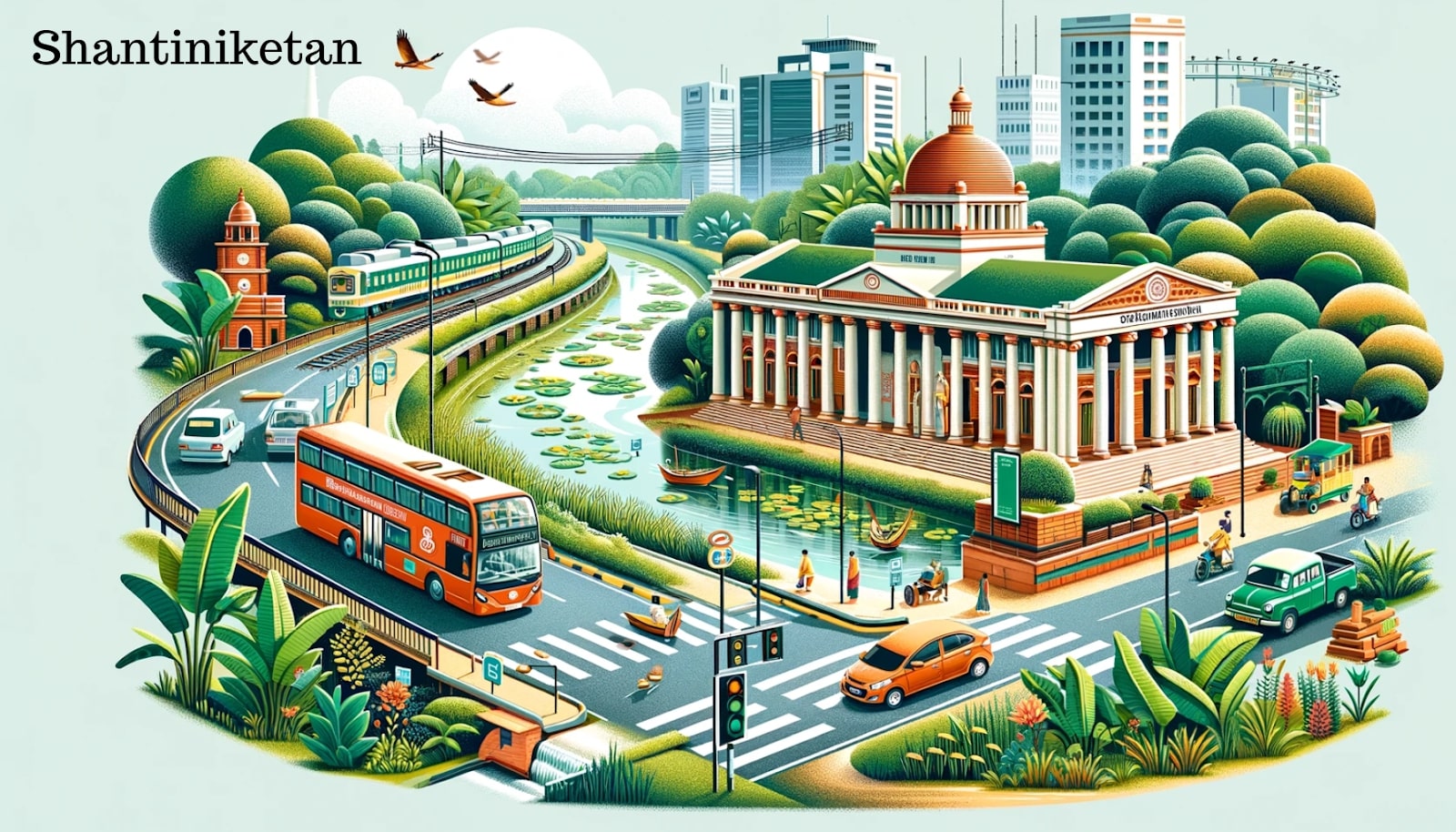
Shantiniketan is a small town in West Bengal, India, known for its rich culture and educational heritage. The Nobel laureate Rabindranath Tagore founded it with a vision to blend education with the culture of the land. Here, students learn about art, music, and nature as part of their everyday life.
Educational Landmark
At the heart of Shantiniketan is the Visva-Bharati University. It’s not like your usual university; it’s an open-air school that takes education beyond classrooms. Tagore believed that learning under trees in a natural environment could spark creativity in students. This idea changed how we look at education in India.
|
Visva-Bharati University |
Details |
|
Founded by |
Rabindranath Tagore |
|
Established in |
1921 |
|
Vision |
To unite the world through education |
|
Teaching Method |
Blend of traditional and modern, with a focus on nature |
Shantiniketan’s Culture and Arts
Shantiniketan is a hub for cultural festivals. The Poush Mela is an annual fair that draws crowds from all over, showcasing local music, dance, and handicrafts. The Basanta Utsav, celebrating spring, is famous for its vibrant colors and lively performances.
Healthcare Facilities
For a small town, Shantiniketan has adequate healthcare facilities. It has hospitals and clinics that cater to the needs of locals and students. Medical care is accessible, ensuring that health needs are met.
Banking and Finance
Banks play a crucial role in Shantiniketan’s economy. They help students with their financial needs and support local businesses. This financial network is vital for the town’s wellbeing.
Shantiniketan’s History
Shantiniketan began with Maharshi Debendranath Tagore, Rabindranath Tagore’s father, who founded an Ashram here. Rabindranath later established a school which grew into the university we know today. Its history is tied to the Tagore family’s efforts to improve education.
Colleges and Other Educational Institutes
Aside from the university, Shantiniketan has various colleges specializing in different subjects, from arts to sciences. Vocational training centers provide practical skills, preparing students for their future careers.
Economic Backbone
The local economy relies on several sources of income. Two of the main pillars are:
- Tourism: Visitors come to experience the culture and history of Shantiniketan.
- Handicrafts: The town is known for its unique crafts, which are sold all over India.
Natural Resources and Agriculture
Shantiniketan is surrounded by nature, with forests that are home to diverse plant life. Agriculture is also a part of life here, with farmers growing rice, vegetables, and more.
Demographics
Shantiniketan is a melting pot of cultures. People from different backgrounds and languages live here. This diversity is reflected in the community’s daily life.
Business Landscape
Local businesses in Shantiniketan range from small shops to medium-sized enterprises. These businesses support the community and provide goods and services necessary for everyday life.
Political Scenario
The political scene in Shantiniketan is influenced by its educational and cultural significance. Local politics often involve discussions on how to preserve the town’s heritage and promote its development.
Historical Significance
Shantiniketan isn’t just a town; it’s a chapter in India’s story. It played a part in the country’s struggle for independence, with leaders and thinkers gathering here to discuss freedom. The place is dotted with historical landmarks, each telling a part of India’s journey.
Natural Beauty
Nature in Shantiniketan is like a painting come to life. Tall trees, open fields, and the peaceful Kopai River make it a haven for nature lovers. This beauty has inspired countless artists, poets, and writers, including Tagore himself.
Tourism Appeal
Shantiniketan is a tourist magnet, known for more than just its educational value. Here’s what attracts visitors:
|
Tourist Attractions |
Description |
|
Tagore’s Ashram |
The peaceful home where Tagore lived and wrote. |
|
Poush Mela |
A vibrant annual fair full of local culture. |
|
Amar Kutir |
A cooperative society showcasing handicrafts. |
|
Kala Bhavana |
An institute of fine arts with stunning artwork. |
Visiting Shantiniketan is best during the cooler months, from October to March, when the festivals light up the town.
Sports and Entertainment
Sports are part of the fun in Shantiniketan. Football and cricket are popular among the youth. Entertainment isn’t left behind with cultural performances, music sessions, and art exhibitions that regularly take place, showing off the talents of the locals and students.
Conclusion
In conclusion, Shantiniketan is much more than a town in West Bengal; it’s a living museum of culture, education, and history. The ideals set forth by Rabindranath Tagore have shaped this place into a nurturing ground for the arts, learning, and nature. From the vibrant Poush Mela to the hallowed halls of Visva-Bharati University, Shantiniketan offers a unique glimpse into the soul of India.
As we have explored, the town is a harmonious blend of the old and new. Its historical significance resonates with the spirit of freedom and progress. The natural beauty invites not just the wandering tourists but also ignites the creativity of artists and the curiosity of nature enthusiasts. Its economic and political activities show a community that is self-sustaining and rich in culture and heritage.
Whether you’re drawn to Shantiniketan for its educational legacy, the tranquility of its natural setting, or the warmth of its local festivals and markets, you will find a corner of India that beats to its own rhythm. A rhythm composed by the visionary Tagore and played out through generations. Shantiniketan is not just a place to visit but an experience to live, an education to pursue, and a culture to cherish. It stands as a testament to the power of education, culture, and community to shape a better world.
FAQ
Banks(2) of Shantiniketan City
| Bank name | IFSC code | Address | District | State |
|---|---|---|---|---|
| Bandhan Bank | BDBL0001947 | Ground Floor, Ratanti Bhawan, Village + PO-Illambazar, Birbhum, West Bengal-731214 | Birbhum | WEST BENGAL |
| Bandhan Bank | BDBL0001758 | 305/905, Near New Bus Stand, PO- Rampurhat, PS- Rampurhat, District- Birbhum, West Bengal, Pin-731224 | Birbhum | WEST BENGAL |